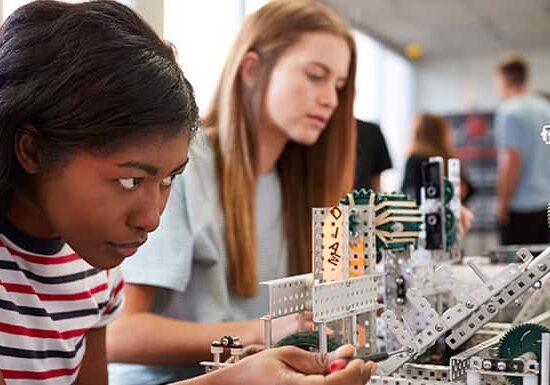What Is Stem Education? It’s Important!
Updated: June 19, 2024

Education provides the foundation for progress. What is STEM education? The future of the world heavily relies on science, technology, engineering, and mathematics. As such, STEM education encompasses these disciplines to prepare and educate students to contribute to the world.
 Photo by Annie Spratt on Unsplash
Photo by Annie Spratt on Unsplash
What is STEM Education?
STEM Education is an interdisciplinary curriculum that teaches Science, Technology, Engineering, and Mathematics in an applied approach. In 2018, the White House’s Office of Science and Technology Policy issued a report and Federal strategy for all students to be able to access STEM education.
In 2019, there was $540 million invested in grant money to make this a reality. This is because demand in the job sector is so high in these industries, so first, education must be supported.
Why Is It Important?
Arguably every industry has something to do with STEM. This is because technology continues to grow and expand. In the past few years alone, 90% of all the world’s data was generated. In order to be able to utilize data and technology for the better, people have to be educated.
STEM jobs are both growing and lucrative. When it comes down to it, the nature of the subjects means that they will continue to evolve and advance.
Benefits of STEM Education
There are many benefits of STEM education, from both a global and personal perspective. Globally, STEM is helping to break down barriers. It’s bridging gender divides and ethnic gaps to provide powerful learning and opportunities to all people.
STEM also sets up students and citizens to be capable of the following:
- Make smart decisions regarding public health and safety
- Manage technology and promote efficient usage
- Find solutions for global issues
- Provide valuable insight for public policy
- Promotes high job security for in-demand skills
STEM in Schools
At all levels of education, students have the power to introduce STEM education. Some important tips to set up the classroom for a collaborative STEM environment are to:
- Arrange desks and furniture in a way that you can maximize students’ flexibility as they work on STEM projects. This may require leaving large aisles or building workstations.
- Students should be encouraged to collaborate and work together.
- You can post key concepts for each subject matter to serve as reminders.
How Do I “STEM” My Classroom?
STEM education starts with the basics, like addition and subtraction. As students get older, you can bring in project-based learning. This is one way to allow students to tackle real-world problems using all the blended knowledge that they need. Before entering college, students can dive deeper into solving problems using research, data, and analytics.
For example, some fun project ideas for teachers who want to add STEM to the classroom could be:
- Build a Catapult: Teach kids about engineering by creating a device that launches things across the room!
- Money Math: Teach math using money
- Use Legos: Utilize legos to teach about engineering, architecture, and design
What Are STEM Majors?
For students who enjoy science, technology, engineering, and mathematics, there are many majors to choose from. Also, not all of them require degrees. Here’s a look at 10 majors within STEM:
- Astronomy
- Biology
- Chemistry
- Computer science
- Engineering
- Earth sciences
- Health sciences
- Information technology
- Mathematics
- Physics
Within each of these fields of study, there are various specialities and branches which open the door to many career opportunities. For those seeking a degree in STEM, some of the most important qualities to possess include:
- Strong analytical thinking skills
- An understanding of how technology works
- Good communication and problem-solving skills
- Strong math skills are helpful, too
Blended Learning
Traditional math and science has always existed in classrooms, but one of the biggest differentiators with STEM education is the blended learning environment. It involves showing students how the scientific method can be applied in all aspects of life. It also involves showing how problem-solving works in real-world situations.
At every level of education, STEM can and should be incorporated. This is what it looks like at varying levels:
- Elementary School: Focuses on the basics of STEM, including raising awareness of jobs in the fields. The goal here is that students will be interested in learning more and eventually pursuing careers in the disciplines.
- Middle School: As education progresses, so does the level of learning. In middle school, STEM subject matter becomes more rigorous.
- High School: Here, students become prepared to pursue higher education in STEM, as well as extracurricular opportunities within the fields.
How Does STEM Improve Learning?
In essence, STEM is a microcosm of life. The interdisciplinary nature of the educational process teaches how to think critically. STEM learning teaches how you can apply knowledge and research for problem-solving.
What Are Some Downsides of STEM Education?
On the other hand, some of the biggest challenges facing STEM education is the allocation of resources. Because it relies on technology, it requires funding, training, and knowledge.
Furthermore, STEM education may not utilize assessment and tests in the way that traditional education does. Instead, it’s focused on critical thinking and problem-solving skills, which aren’t always so clear-cut to gage.
What is STEAM Education?
If there was one thing missing from STEM education, it’s “arts.” As such, some have incorporated arts into the STEM curriculum to make it STEAM. This is because art also requires critical thinking and can be used in real-life situations for problem-solving,
For example, think of an architect. That’s a particular discipline that really utilizes every subject in STEAM.
How To Get Kids Interested in STEM?
Since STEM education is lifelong, it’s worthwhile to promote STEM learning in early education. You can bring STEM into all aspects of life from a young age.
Some ideas to do so include:
- Cooking: Cooking and baking are fun exercises for kids to learn how to use science and measurements while blending in creativity.
- Music lessons: Music lessons can teach kids how sound works and can even lead to a passion of music and interest in sound engineering, for example.
- Shopping: You can use shopping as an experience to teach matCurrent interests: Every interest your child currently has can be a teaching experience.
- Video games: Video games are a great way to get kids involved in Computer Science. You can start with basic coding, and they can make their own games!
- Experiments: Jump straight into science with experiments! Experiments can involve household items or even can be cooking experiments.
STEM Skills are in High Demand
Across America and the world, STEM skills are in high demand. Most of the fields are growing at an above average rate. Some of the fastest growing jobs include:
- Software Developer
- Statistician
- Mechanical Engineer
- Data Analyst
STEM Scholarships
As there is such a high demand for STEM experts in the world, there are plenty of STEM scholarships out there to help aid students wishing to pursue this field.
STEM scholarships provide financial aid to students who study science, technology, engineering, and mathematics. They aid in helping college be more affordable. Here’s a list of some STEM scholarships.
 Photo by Kelly Sikkema on Unsplash
Photo by Kelly Sikkema on Unsplash
Alternative Options
Attending traditional college campuses isn’t the only way to major in STEM fields. For example, at the University of the People, students from all around the world can partake in earning their Computer Science degree. The institution runs entirely online and is tuition-free. Therefore, it’s affordable and accessible for all.
The Wrap Up
The world revolves around the usage of science, math, engineering, and technology. STEM education is a blended learning structure that aims to provide students with necessary knowledge for problem-solving and growth.
At any educational level, you can support the love of STEM learning in students.


 Photo by
Photo by  Photo by
Photo by